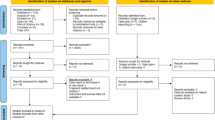Abstract
Data sources
Medline and the OpenThesis database.
Study selection
Randomised clinical trials (RCTs) and cohort studies comparing the incidence of root fractures of metallic and fibre-reinforced composite posts with more than five years follow up were considered.
Data extraction and synthesis
Two reviewers independently selected studies and assessed study quality. The Cochrane risk of bias tool was used to assess RCTs and the Newcastle-Ottawa Scale for cohort studies. Root fracture leading to tooth extraction was considered a catastrophic failure and defined as the primary outcome. Secondary outcomes (non-catastrophic failures) included endodontic failures, crown dislodgement, post debonding, and post/core fractures. The incidence rate of root fractures and non-catastrophic failures was calculated by dividing the number of events by the period of risk for all included posts during the study period per 1000 post years of follow-up.
Results
Fourteen studies (seven RCTs and seven cohorts) were included involving 3202 patients and 4752 posts. In all there were 62 root fractures and 467 non-catastrophic failures.
The incidence rate of root fractures (pooled event rate per 1000 post years) for metal posts (four RCTs, four cohorts) was 5.13 (95% CI, 4.05–6.21) compared with 4.78 (95% CI, 4.28–5.27) for the fibre-reinforced posts (five RCTs, three cohorts). The pooled survival rate for was metal posts = 90% (95% CI 85.5– 93.3) compared with 83.9% (95% 67.6–92.8) for fibre-reinforced posts. Heterogeneity between the studies was high. The incidence rate of non-catastrophic failures for metal-based posts (four RCTs, 3 cohorts) was 12.69 (95% CI, 7.90–17.48) per 1000 post years compared with 19.39 (95% CI, 13.21–25.57) for fibre-reinforced posts. Heterogeneity was again important.
Conclusions
The results of the present systematic review based on clinical studies do not support the indication of fibre-reinforced posts based on a reduction of catastrophic failures. However, this review also showed the need for further well designed clinical studies evaluating intra-radicular posts.
Similar content being viewed by others
Commentary
The restorative core on a ‘root-canaled’ tooth is often retained with a post. However, inserting a post into the root canal system does not come without risks, particularly the risk of root fracture.1 The fibre-reinforced composite post is proposed as an alternative to conventional metal post systems (prefabricated metal post or cast post) with the potential of reducing this risk.2 The aim of this review was to test the hypothesis that indirect crowns seated on core restorations retained by fibre reinforced composite posts have a lower incidence of root fracture and a higher survival rate than those retained with a metal post.
The authors limited their search to articles cited in the MEDLINE and OpenThesis databases, as well as the articles (hand-searched) referenced in the retrieved articles. At a minimum, the search should have included the database EMBASE and possibly Open Grey (www.opengrey.eu). EMBASE is the European equivalent of the North American based MEDLINE, and Open Grey is a database of research reports, doctoral dissertations, conference papers and other grey literature. Considering the review had no language limitation and that many of the cited studies were conducted in Europe, it is possible that some relevant studies were missed.
The search included randomised control trials (RCT) and cohort reports where relevant prognostic data could be extracted from at least one arm of the study. However, summary characteristics of the fourteen included studies (seven RCTs and seven cohort) were presented without a description of the design, size, intervention and results of each individual study. Such details would have added to the transparency of the review and allowed the reader to better appraise the review's results and conclusions. Further lack of transparency in this review was demonstrated by not referencing the citations of the nine full-text articles excluded from this review.
I searched and reviewed the detailed characteristics of all fourteen individual included studies, and found that only two actually compared the clinical performance of metal posts with fibre-reinforced composite posts.3,4 Both these studies had small sample sizes and showed no appreciable difference in the rate of root fracture and clinical survival between the two systems. This means that the meta-analysis of this review is based predominantly from data extracted from one of the study arms of the other twelve included papers. However, significant statistical heterogeneity was found amongst included studies; a subgroup analysis was not able to identify where the heterogeneity was coming from. Furthermore, the included studies demonstrated significant risk of bias in many domains. Considering the significant heterogeneity and risk of bias, the results of this review should be interpreted with caution, particularly when generalising them to clinical practice.
The incidence of root fractures is given per 1000 post years, where a ‘post year’ is the sum of the observation time (in years) of the total at-risk population of posts. Using post-years rather than just years in the denominator accounts for situations where the amount of observation time differs between posts under investigation, or when the number of posts at risk in each study varies with time.5 Use of the measure implies that the incidence rate is constant over time. For example, this review gives a catastrophic incidence rate for metal-based and fibre-reinforced composite posts to be 5.13 and 4.78 per 1000 post years respectively. This is clinically interpreted to mean that for either the metal-based or the fibre-reinforced posts, about five catastrophic events can be expected per 1000 posts observed for one year, or 100 posts observed over ten years.
The authors admitted the difficulty of making sense of a poor body of knowledge regarding the prognosis of post-retained restorations. Nevertheless, the validity of conducting a meta-analysis based on aggregated data statistically combined from the distinct statistical outcome of each included study is questionable. An alternative is a meta-analysis based on individual patient data (IPD). Such an approach requires querying the authors of each included study for the individual raw data of each patient/post event. When combined this way, the generated summary estimate and statistics are more valid and accurate.6 However, this approach is more rigorous, time consuming and expensive.
In the meantime, the jury is still out on the comparative prognosis between metal-based and fibre-reinforced composite post-retained core restorations.
References
Bateman G, Ricketts DN, Saunders WP . Fibre-based post systems: a review. Br Dent J 2003; 195: 43–48: discussion 37.
Rosenstiel SF, Land MF . Contemporary Fixed Prosthodontics 3rd Mosy Inc St Louis 2001, p.276-283.
King PA, Setchell DJ, Rees JS . Clinical evaluation of a carbon fibre reinforced carbon endodontic post. J Oral Rehabil 2003; 30: 785–789.
Sterzenbach G, Franke A, Naumann M . Rigid versus flexible dentine-like endodontic posts--clinical testing of a biomechanical concept: seven-year results of a randomized controlled clinical pilot trial on endodontically treated abutment teeth with severe hard tissue loss. J Endod 2012; 38: 1557–1563.
Last, J M ., A Dictionary of Epidemiology (4th ed) (2001). New York, NY: Oxford University Press. p.92
Stewart LA, Tierney JF . To IPD or not to IPD? Advantages and disadvantages of systematic reviews using individual patient data. Eval Health Prof 2002; 25: 76–97.
Author information
Authors and Affiliations
Additional information
Address for correspondence: Dr Andre Luis Faria-e-Silva, Universidade Federal de Sergipe, Hospital Universitario, Departamento de Odontologia, Rua Claudio Batista, s/n Bairro Sanatorio, Aracaju, Sergipe, Brazil, CEP 49060-100. E-mail: fariaesilva.andre@gmail.com
Figueiredo FE, Martins-Filho PR, Faria-E-Silva AL. Do metal post-retained restorations result in more root fractures than fiber post-retained restorations? A systematic review and meta-analysis. J Endod 2015; 41: 309–316.
Rights and permissions
About this article
Cite this article
Balevi, B. Metal or fibre posts and root fractures. Evid Based Dent 16, 80–81 (2015). https://doi.org/10.1038/sj.ebd.6401115
Published:
Issue Date:
DOI: https://doi.org/10.1038/sj.ebd.6401115



